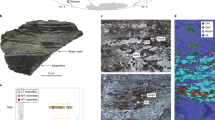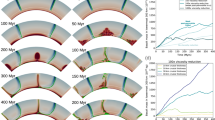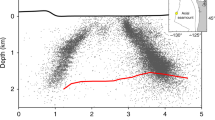Abstract
At the south pole of Saturn’s icy moon Enceladus, eruptions of water vapour and ice emanate from warm tectonic ridges1,2,3,4. Observations in the infrared5 and visible6 spectra have shown an orbital modulation of the plume brightness, which suggests that the eruption activity is influenced by tidal forces. However, the observed activity seems to be delayed by several hours with respect to predictions based on simple tidal models6,7. Here we simulate the viscoelastic tidal response of Enceladus with a full three-dimensional numerical model8,9 and show that the delay in eruption activity may be a natural consequence of the viscosity structure in the south-polar region and the size of the putative subsurface ocean. By systematically comparing simulations of variations in normal stress along faults with plume brightness data, we show that the observed activity is reproduced for two classes of interior models with contrasting thermal histories: a low-viscosity convective region above a polar sea extending about 45°–60° from the south pole at a depth below the surface as small as 30 km, or a convecting ice shell of 60–70 km in thickness above a global ocean. Our analysis further shows that the eruption activity is controlled by the average normal stress applied across the cracks, thus providing a constraint on the eruption mechanism.
This is a preview of subscription content, access via your institution
Access options
Subscribe to this journal
Receive 12 print issues and online access
$259.00 per year
only $21.58 per issue
Buy this article
- Purchase on Springer Link
- Instant access to full article PDF
Prices may be subject to local taxes which are calculated during checkout




Similar content being viewed by others
References
Porco, C. C. et al. Cassini observes the active south pole of Enceladus. Science 311, 1393–1401 (2006).
Hansen, C. J. et al. Enceladus’ water vapor plume. Science 311, 1422–1425 (2006).
Spencer, J. R. et al. Cassini encounters Enceladus: Background and the discovery of a south polar hot spot. Science 311, 1401–1405 (2006).
Spencer, J. R. et al. in Saturn from Cassini-Huygens (eds Dougherty, M. K. et al.) 683–724 (Springer, 2009).
Hedman, M. M. et al. An observed correlation between plume activity and tidal stresses on Enceladus. Nature 500, 182–184 (2013).
Nimmo, F., Porco, C. C. & Mitchell, C. Tidally modulated eruptions on Enceladus: Cassini ISS observations and models. Astron. J. 148, 46 (2014).
Hurford, T. A., Helfenstein, P., Hoppa, G. V., Greenberg, R. & Bills, B. G. Eruptions arising from tidally controlled periodic openings of rifts on Enceladus. Nature 447, 292–294 (2007).
Běhounková, M., Tobie, G., Choblet, G. & Čadek, O. Coupling mantle convection and tidal dissipation: Applications to Enceladus and Earth-like planets. J. Geophys. Res. 115, E09011 (2010).
Běhounková, M., Tobie, G., Choblet, G. & Čadek, O. Tidally-induced melting events as the origin of south-pole activity on Enceladus. Icarus 219, 655–664 (2012).
Porco, C. C., DiNino, D. & Nimmo, F. How the geysers, tidal stresses, and thermal emission across the south polar terrain of Enceladus are related. Astron. J. 148, 45 (2014).
Nimmo, F., Spencer, J. R., Pappalardo, R. T. & Mullen, M. E. Shear heating as the origin of the plumes and heat flux on Enceladus. Nature 447, 289–291 (2007).
Hurford, T. A., Helfenstein, P. & Spitale, J. N. Tidal control of jet eruptions on Enceladus as observed by Cassini ISS between 2005 and 2007. Icarus 220, 896–903 (2012).
Tobie, G., Čadek, O. & Sotin, C. Solid tidal friction above a liquid water reservoir as the origin of the south pole hotspot on Enceladus. Icarus 196, 642–652 (2008).
Schubert, G., Anderson, J. D., Travis, B. J. & Palguta, J. Enceladus: Present internal structure and differentiation by early and long-term radiogenic heating. Icarus 188, 345–355 (2007).
Iess, L. et al. The gravity field and interior structure of Enceladus. Science 344, 78–80 (2014).
Spencer, J. R. & Nimmo, F. Enceladus: An active ice world in the Saturn system. Annu. Rev. Earth Planet. Sci. 41, 693–717 (2015).
Collins, G. C. & Goodman, J. C. Enceladus’ south polar sea. Icarus 189, 72–82 (2007).
Nimmo, F., Bills, B. G. & Thomas, P. C. Geophysical implications of the long-wavelength topography of the Saturnian satellites. J. Geophys. Res. 116, E11001 (2011).
McKinnon, W. B. Effect of Enceladus? Rapid synchronous spin on interpretation of Cassini gravity. Geohys. Res. Lett. 42, 2137–2143 (2015).
Kalousová, K., Souček, O. & Čadek, O. Deformation of an elastic shell with variable thickness: A comparison of different methods. Geophys. J. Int. 190, 726–744 (2012).
Postberg, F., Schmidt, J., Hillier, J., Kempf, S. & Srama, R. A salt-water reservoir as the source of a compositionally stratified plume on Enceladus. Nature 474, 620–622 (2011).
Ingersoll, A. P. & Ewald, S. P. Total particulate mass in Enceladus plumes and mass of Saturn’s E ring inferred from Cassini ISS images. Icarus 216, 492–506 (2011).
Schmidt, J., Brilliantov, N., Spahn, F. & Kempf, S. Slow dust in Enceladus’ plume from condensation and wall collisions in tiger stripe fractures. Nature 451, 685–688 (2008).
Ingersoll, A. P. & Pankine, A. A. Subsurface heat transfer on Enceladus: Conditions under which melting occurs. Icarus 206, 594–607 (2009).
Qin, C., Zhong, S. & Wahr, J. M. Constraining long-wavelength elastic structure of the lunar mantle using GRAIL tidal love numbers. Lunar Planet. Sci. Conf. 45, abstr. 1777 (2014).
Williams, J. G. et al. Lunar interior properties from the GRAIL mission. J. Geophys. Res. 119, 1546–1578 (2014).
Kaula, W. Tidal dissipation by solid friction and the resulting orbital evolution. Rev. Geophys. 2, 661–685 (1964).
Efroimsky, M. Tidal dissipation compared to seismic dissipation: In small bodies, Earths, and super-Earths. Astrophys. J. 746, 150 (2012).
Castillo-Rogez, J. C., Efroimsky, M. & Lainey, V. The tidal history of Iapetus: Spin dynamics in the light of a refined dissipation model. J. Geophys. Res. 116, E09008 (2011).
Tobie, G., Mocquet, G. & Sotin, C. Tidal dissipation within large icy satellites: Applications to Europa and Titan. Icarus 177, 534–549 (2005).
Běhounková, M., Tobie, G., Choblet, G. & Čadek, O. Impact of tidal heating on the onset of convection in Enceladus’s ice shell. Icarus 226, 898–904 (2013).
Hurford, T. A. et al. Geological implications of a physical libration on Enceladus. Icarus 203, 541–552 (2009).
Wahr, J. et al. Modeling stresses on satellites due to nonsynchronous rotation and orbital eccentricity using gravitational potential theory. Icarus 200, 188–206 (2008).
Smith-Konter, B. & Pappalardo, R. T. Tidally driven stress accumulation and shear failure of Enceladus’s tiger stripes. Icarus 198, 435–451 (2008).
Acknowledgements
The research leading to these results has received financial support from the European Research Council under the European Community’s Seventh Framework Programme (FP7/2007-2013 Grant Agreement no. 259285) and from the Czech Science Foundation (project no. 14-04145S). C.P. acknowledges support from NASA CDAP, and F.N. from the CDAP-PS programme. The computations were carried out using CCIPL computational facilities (France) and IT4Innovations Centre (Excellence project CZ.1.05/1.1.00/02.0070, project Large Research, Development and Innovations Infrastructures no. LM2011033, Czech Republic).
Author information
Authors and Affiliations
Contributions
All authors contributed to the data analysis, the results discussion, and the paper writing. M.B. carried out the numerical calculations. O.Č. and M.B. contributed to the code development.
Corresponding author
Ethics declarations
Competing interests
The authors declare no competing financial interests.
Supplementary information
Supplementary Information
Supplementary Information (PDF 8437 kb)
Rights and permissions
About this article
Cite this article
Běhounková, M., Tobie, G., Čadek, O. et al. Timing of water plume eruptions on Enceladus explained by interior viscosity structure. Nature Geosci 8, 601–604 (2015). https://doi.org/10.1038/ngeo2475
Received:
Accepted:
Published:
Issue Date:
DOI: https://doi.org/10.1038/ngeo2475
This article is cited by
-
Enceladus as a potential oasis for life: Science goals and investigations for future explorations
Experimental Astronomy (2022)
-
Ice-Ocean Exchange Processes in the Jovian and Saturnian Satellites
Space Science Reviews (2020)
-
The Martian subsurface as a potential window into the origin of life
Nature Geoscience (2018)
-
Powering prolonged hydrothermal activity inside Enceladus
Nature Astronomy (2017)
-
Tidal effects in differentiated viscoelastic bodies: a numerical approach
Celestial Mechanics and Dynamical Astronomy (2017)



